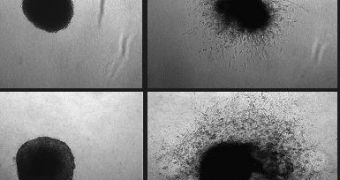A team of scientists at the Montreal Neurological Institute and Hospital of McGill University, discovered the process that allows tumor cells to invade normal tissue.
Their findings should prove vital to diagnose tools and help develop new and more effective strategies to stop cancer cells from spreading.
The researchers found that the strong molecular 'glue' that can normally be found on the surface of cells, and which is responsible for binding normal cells together, is missing from the surface of aggressive tumor cells.
This is what allows tumor cells to break away from one another and 'walk' towards other regions of the body.
Dr. David Colman, director of The Neuro and corresponding author of the study, said that they “were concerned that previous research showed that N-cadherin, an adhesive molecule, was important for both normal tissue organization, as well as tumor metastasis.
“We therefore decided to further investigate this apparent paradox,” so the team focused on the levels of N-cadherin on tumor cell surfaces.
Dr. Deborah Maret, research associate and lead author said that the “study shows that a non-adhesive form of N-cadherin, termed proNcad is present in a much higher proportion on the surfaces of the most invasive melanoma, brain tumor cells, breast cancer and prostate tumor cells, compared to less invasive tumor cells.”
This non-adhesive form of N-cadherin never actually reaches the cell surface in normal tissues, but “it appears that although total N-cadherin levels remain constant, the higher levels of the non-adhesive proNcad promote detachment, tumor cell migration and invasion.
“This supports an overall conclusion that non-adhesive (proNcad) and adhesive (Ncad) forms of cadherins co-exist on tumor cell surfaces, but it is the ratio between these functionally opposite molecules that directly dictates the invasion potential of tumor cells,” adds Dr Maret.
The reason for which the non-adhesive proNcad form was not previously identified on tumor cell surfaces, was that the differences between the two forms of cadherin are extremely small, and scientists logically assumed that all Ncad on the tumor cell surface was of the adhesive type.
According to Dr. Colman, when the team realized their mistake, they “were astounded”.
Dr. Rolando Del Maestro, director of The Brain tumor Research Center and a co-author on the study explains that “as a brain tumor surgeon, I know that stopping cancer cells from migrating is critical for patient survival.”
The proteins on the surface of cells are called cadherins, and they have a very important role in 'gluing' cells together (cell adhesion), so that the tissue can function properly.
The problem is that it is not entirely clear what happens to the cells and the adhesive between them in tumor growth and metastases, but Dr. Del Maestro assured that they “are determined to improve treatment options for patients.
“We have already introduced new neurosurgical methods and technologies that are unique in North America and are spearheading multidisciplinary initiatives to advance brain tumor research.”
These findings, published in this week’s issue of the journal Neoplasia, could bring a new approach to the ending of the metastatic spread of invasive tumor cells.

 14 DAY TRIAL //
14 DAY TRIAL //